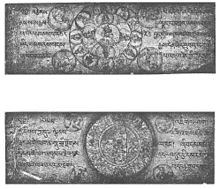বার-দো-থোস-গ্রোল
বার-দো-থোস-গ্রোল (তিব্বতি: བར་དོ་ཐོས་གྲོལ, ওয়াইলি: bar-do thos-grol) তিব্বতী বৌদ্ধধর্মের র্ন্যিং মা সম্প্রদায়ের একটি বিখ্যাত গ্রন্থ।

| বার-দো-থোস-গ্রোল | |||||||||||
| তিব্বতি নাম | |||||||||||
|---|---|---|---|---|---|---|---|---|---|---|---|
| তিব্বতি | བར་དོ་ཐོས་གྲོལ | ||||||||||
| |||||||||||
| চীনা নাম | |||||||||||
| ঐতিহ্যবাহী চীনা | 《西藏度亡經/中陰得度法/中陰解脫經》 | ||||||||||
| সরলীকৃত চীনা | 《西藏度亡经/中阴得度法/中阴解脱经》 | ||||||||||
| |||||||||||
ইতিহাস
সম্পাদনাঅষ্টম শতাব্দীতে পদ্মসম্ভব বার-দো-থোস-গ্রোল গ্রন্থ রচনা করেন এবং তার ধর্মসঙ্গিনী ও পঁচিশ প্রধান শিষ্যের মধ্যে একজন য়ে-শেস-ম্ত্শো-র্গ্যাল লিখে রাখেন। এরপর এই গ্রন্থকে গ্তের-মার মর্যাদা দিয়ে মধ্য তিব্বত অঞ্চলের গাম্পো পর্বতে পুঁতে রাখা হয়। চতুর্দশ শতাব্দীতে বিখ্যাত তিব্বতী গ্তের-স্তোন কার-মা-গ্লিং-পা এই গ্রন্থকে পুনরায় আবিষ্কার করেন। [১][২][৩]
বিষয়
সম্পাদনাবার-দো-থোস-গ্রোল গ্রন্থে মৃত্যু ও পুনর্জন্মের মধ্যবর্তী অবস্থায় চৈতন্যের অবস্থা ও অভিজ্ঞতাকে বর্ণনা করা হয়েছে। এই মধ্যবর্তী অবস্থাকে তিব্বতী ভাষায় বার-দো বলা হয়। এই গ্রন্থে মৃত্যুকালীন আচার অনুষ্ঠান সম্বন্ধেও বর্ণনা রয়েছে।[৪]
তিব্বতী মৃতের বই
সম্পাদনা১৯২৭ খ্রিষ্টাব্দে এই বই বিখ্যাত প্রত্নতত্ত্ববিদ ওয়াল্টার য়ীলিং ইভান্স-ওয়েন্টজ টিবেটান বুক অব দ্য ডেড বা তিব্বতী মৃতের বই নামে প্রকাশ করেন। [৫] যদিও তিব্বতী মৃতের বই তিব্বতী ভাষায় প্রতিশব্দ বার-দো-থোস-গ্রোল নয়।[n ৬]
পাদটীকা
সম্পাদনা- ↑ তিব্বতীতে জাব-ছোস-ঝি-খ্রো-দ্গোংস-পা-রাং-গ্রোল (ওয়াইলি: zab chos zhi khro dgongs pa rang grol)
- ↑ তিব্বতীতে কার-গ্লিং-ঝি-খ্রো (ওয়াইলি: kar gling zhi khro)
- ↑ তিব্বতীতে ছোস-ন্যিদ-বার-দো'ই-গ্সোল-'দেব্স-থোস-গ্রোল-চেন-মো (ওয়াইলি: chos nyid bar do'i gsol 'debs thos grol chen mo)
- ↑ তিব্বতীতে স্ত্রিদ-পা'ই-বার-দো-ঙ্গো-স্প্রোদ-গ্সোল-'দেব্স-থোস-গ্রোল-চেন-মো (ওয়াইলি: strid pa'i bar do ngo sprod gsol 'debs thos grol chen mo)
- ↑ তিব্বতীতে বার-দো-থোস-গ্রোল (ওয়াইলি: bar do thos grol), থোস-গ্রোল-চেন-মো (ওয়াইলি: thos grol chen mo) এবং থোস-গ্রোল (ওয়াইলি: thos grol)
- ↑ ...there is in fact no single Tibetan title corresponding to the Tibetan Book of the Dead. The overall name given to the whole terma cycle is Profound Dharma of Self-Liberation through the Intention of the Peaceful and Wrathful Ones,[n ১] and it is popularly known as Karma Lingpa's Peaceful and Wrathful Ones.[n ২] It has been handed down through the centuries in several versions containing varying numbers of sections and subsections, arranged in different orders, ranging from around ten to thirty-eight titles. These individual texts cover a wide range of subjects, including the dzogchen view..., meditation instructions, visualizations of deities, liturgies and prayers, lists of mantras, descriptions of the signs of death, and indications of future rebirth, as well as those that are actually concerned with the after-death state. the [sic.] Tibetan Book of the Dead as we know it in English consists of two comparatively long texts on the bardo of dharmata (including the bardo of dying) and the bardo of existence... They are called Great Liberation through Hearing: The Supplication of the Bardo of Dharmata[n ৩] and Great liberation through Hearing: The Supplication Pointing Out the Bardo of Existence[n ৪] Within the texts themselves, the two combined are referred to as Liberation through Hearing in the Bardo, Great Liberation through Hearing, or just Liberation through Hearing,......[n ৫][৬]:২০
তথ্যসূত্র
সম্পাদনা- ↑ Evans-Wentz (1960), p. liv; and, Fremantle & Trungpa (2003), p. xi.
- ↑ 'Guru Rinpoche' and 'Yeshe Tsogyal' in: Forbes, Andrew; Henley, David (2013). The Illustrated Tibetan Book of the Dead. Chiang Mai: Cognoscenti Books. B00BCRLONM
- ↑ 寧瑪派版 《死者之書》 的死後世界
- ↑ Dorje, Gyurme. The Tibetan Book of the Dead. "A Brief Literary History of the Tibetan Book of the Dead. (Penguin Classics Deluxe Edition, 2007). Translated by Gyurme Dorje. আইএসবিএন ৯৭৮-০-১৪-৩১০৪৯৪-০.
- ↑ Evans-Wentz, W. Y., সম্পাদক (১৯৬০) [1927]। "The Tibetan Book of the Dead" (পিডিএফ) (1957 1st (ebook translation) সংস্করণ)। Oxford University Press।
- ↑ Fremantle, Francesca (2001). Luminous Emptiness: understanding the Tibetan Book of the dead. Boston, MA: Shambhala Publications আইএসবিএন ১-৫৭০৬২-৪৫০-X
অনুবাদকর্ম
সম্পাদনা- Coleman, Graham, with Thupten Jinpa (eds.) (2005) The Tibetan Book of the Dead: The Great Liberation by Hearing in the Intermediate States Tibetan title; composed by Padmasambhava; revealed by Karma Lingpa; translated by Gyurme Dorje. London: Penguin Books আইএসবিএন ৯৭৮-০-১৪-০৪৫৫২৯-৮ (the first complete translation). Also: New York: Viking Penguin, NY, 2006. আইএসবিএন ০-৬৭০-৮৫৮৮৬-২ (hc); আইএসবিএন ৯৭৮-০-১৪-৩১০৪৯৪-০ (pbk).
- Edward Conze (1959) Buddhist Scriptures Harmondsworth: Penguin
- Evans-Wentz, W. Y. (ed.) (1927) Tibetan Book of the Dead: or, The After-Death Experiences on the Bardo Plane; translated by Kazi Dawa Samdup Oxford: Clarendon Press আইএসবিএন ০-১৯-৫০০২২৩-৭
- Francesca Fremantle & Chögyam Trungpa (1975) The Tibetan Book of the Dead: The Great Liberation through Hearing in the Bardo by Guru Rinpoche according to Karma Lingpa. Boulder: Shambhala আইএসবিএন ০-৩৯৪-৭৩০৬৪-X, আইএসবিএন ১-৫৯০৩০-০৫৯-৯ (reissued 2003).
- Thupten Jinpa (ed.) (2005) The Tibetan Book of the Dead (Penguin Classics). London: Penguin Books (2005) আইএসবিএন ০-৭১৩৯-৯৪১৪-২
- Robert Thurman (1994) The Tibetan Book of the Dead, as popularly known in the West; known in Tibet as "The Great Book of Natural Liberation Through Understanding in the Between"; foreword by the Tenzin Gyatso, 14th Dalai Lama, London: Harper Collins আইএসবিএন ১-৮৫৫৩৮-৪১২-৪
আরো পড়ুন
সম্পাদনা- Chökyi Nyima Rinpoche (1991) The Bardo Guidebook Rangjung Yeshe Publications 1991.
- Fremantle, Francesca (2001). Luminous Emptiness: understanding the Tibetan Book of the dead. Boston, MA: Shambhala Publications আইএসবিএন ১-৫৭০৬২-৪৫০-X
- Lati Rinpoche & Jeffrey Hopkins (1985) Death, Intermediate State and Rebirth, Ithaca: Snow Lion
- Timothy Leary, Ralph Metzner & Richard Alpert (1964) The Psychedelic Experience: A Manual Based on the Tibetan Book of the Dead আইএসবিএন ০-৮০৬৫-১৬৫২-৬
- Lodo, Lama (1987) Bardo Teachings. Ithaca: Snow Lion
- Mullin, Glenn H. (1986) Death and Dying: the Tibetan Tradition Penguin-Arkana আইএসবিএন ০-১৪-০১৯০১৩-৯
- Sögyal Rinpoche, with Gaffney, Patrick & Harvey, Andrew (eds.) (1992) The Tibetan Book of Living and Dying. San Francisco: Harper আইএসবিএন ০-০৬-২৫০৭৯৩-১
- Mark Griffin The Bardo Thodol - A Golden Opportunity. 2008.. Los Angeles: HardLight Publishing. আইএসবিএন ৯৭৮-০-৯৭৫৯০২০-২-৮
বহিঃসংযোগ
সম্পাদনা- History article ওয়েব্যাক মেশিনে আর্কাইভকৃত ১৭ মে ২০০৮ তারিখে
- Bardo Thodol - The Tibetan Book of the Dead - Public Domain PDF ebook
- The Tibetan Book of the Dead - Ebook
- "The Life, Death and Rebirth of The Tibetan Book of the Dead", Donald S. Lopez Jr., Berfrois, 13 April 2011